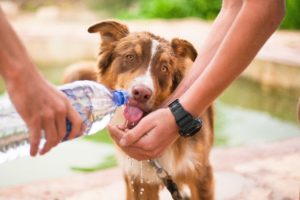Firm, extra firm, super firm, medium, silken, or soft. Nope, I’m not describing mattresses or dog beds. These are all types of tofu! And even if you’re not a vegetarian or vegan, you’ve probably eaten tofu a time or two. This versatile protein doesn’t carry much of a taste on its own, allowing chefs to blend it into almost anything. It’s low-fat but packed with nutrients. And with that knowledge, you’ve probably considered sharing it with your family canine. After all, everyone knows dogs need a healthy dose of protein in their regular diet. So can dogs eat tofu? The answer isn’t simple. While tofu – and soy, in general – isn’t toxic, it also isn’t the best protein for dogs. Let’s show you why.
Tofu
Tofu got its start in China over TWO THOUSAND years ago. You take soy milk and add an acid, which causes it to coagulate. This leaves you with bean curd. Take the curds and press them tight into molds, and you get solid white blocks of tofu. How hard you press the blocks determines the softness (and type) of tofu that results. And the curds retain their sponginess, which is why it’s so easy for tofu to absorb different flavors during cooking.
People flock to tofu because it’s healthy. The soy contains plenty of protein that’s plant-based versus animal-based (keeping vegetarians and vegans happy). And you also find nutrients and minerals – before you add seasonings or flavor (though not many people eat raw tofu). A single slice of silken tofu contains:
- Calories: 46.2
- Carbohydrates: 2.4g
- Fat: 2.3g
- Protein: 4g
- Minerals:
- Calcium: 26mg
- Iron: 0.7mg
- Magnesium: 24.4mg
- Phosphorous: 52.1mg
- Sodium: 4.2mg
When dogs eat tofu, they’re not getting a load of fat or sodium you have to worry about. And they DO need protein in their diets. The ratio of protein in tofu isn’t bad; it’s one reason it features so prominently in vegetarian/vegan diets. The more protein you consume, the less hungry you feel. This helps when you’re dealing with overweight pups. And low cholesterol and fat promote a healthy cardiac system. That sets tofu ahead of animal proteins – in humans.
Can Dogs Eat Tofu?
You won’t find anything toxic in tofu. The logic then dictates it’s okay for dogs to eat tofu. And plenty of people want to convert their dogs to a vegetarian diet. (Please note: dogs CANNOT go vegan) With a protein source available in the form of soy, they swap out their dog’s usual diet for tofu. And while an occasional snack of tofu won’t harm your dog, it’s NOT the protein perfection some people think. Not all proteins are created equal – or processed the same. This is where the problems come in when dogs eat tofu.

Precautions When Dogs Eat Tofu
Our digestive system doesn’t mind tofu. With time, it adapts to using tofu (and other plants) as the primary protein source. And you DO get protein out of soy. It’s not as much as you’d find in meat (a chicken breast has 43g, for instance), but it’s there. And that’s the problem when dogs eat tofu. They’re not getting the proper AMOUNT of protein they need. Also, soy can lead to health problems. While dogs handle ingestion of some fruits and “vegetables” without a problem (people forget zucchini’s a fruit, not a vegetable), soy tends to show up on the problem list. If you want to incorporate tofu into your dog’s diet, you need to proceed slowly.
Protein
Dogs are omnivores. And converting them to a vegetarian diet is DIFFICULT. Attempting to do so on your own (successfully) is impossible. You MUST consult with a board-certified veterinary nutritionist. If canines don’t receive the proper amounts of protein, they’ll start showing symptoms of ill-health:
- Loss of appetite
- Weakness
- Weight loss
- Brittle bones
- Poor growth
- Unthrifty coat
- Behavior changes
Allergies
When some dogs eat tofu, you see a startling reaction: they ITCH. They may also end up frantically licking a certain patch of skin. You could see facial swelling or find yourself dealing with constant ear infections. Or – at the worst – your dog may suffer from vomiting and diarrhea. These point to one thing: your dog’s allergic to soy. Soy is one of the more common dog allergies out there, and tofu is processed soy milk. This means you need to avoid ANYTHING with soy, including:
- Soybeans
- Soy milk
- Tempeh
The safest way for your dog to enjoy soy is a hydrolyzed soy protein. The process breaks down the protein into the component amino acids. Hydrolyzed soy is found in prescription diets, and they’re used in elimination diet trials to pinpoint canine allergies. If you find your dog showing symptoms, though, you need to AVOID soy. It’s only fair.
Hormones
Soy contains phytoestrogens. Phytoestrogens are plant-based compounds that behave like female hormones. And if dogs eat tofu too often? Those phytoestrogens can wreak havoc. You’ll see hormonal imbalances cropping up. Their beautiful hair coat may start to thin and lose its sheen. Skin issues can develop (sometimes confused for pyoderma or allergies). And, at the worst, the thyroid can start to go haywire.
Safe Ways for Dogs to Eat Tofu
We like to think our dogs are like us. If we eat something, so can they. And while tofu isn’t toxic and offers dogs health benefits, it’s also NOT something they should consume regularly. If you want to include tofu in your dog’s diet, you need to keep the portions small and OCCASIONAL to prevent health complications.
Dogs DON’T need flavored tofu. Plain, ROOM TEMPERATURE tofu is the best option. (A cold piece hitting their stomach will cause upset) You want to skip marinades, oils, seasonings, spices, and sauces. YOU may not want to eat plain tofu, but your dog won’t mind in the slightest – trust me. Cut it into cubes appropriate for the size of your pup and mix it into their food.
Some dogs may experience gas following their tofu treat. Make sure you have them remain settled and calm afterward. If they run around and get excited, the gas build-up could lead to a bloat situation in deep-chested dogs. This is ALWAYS an emergency. If you see a distended abdomen or retching without producing vomiting, get to the vet ASAP.
Tofu or Not Tofu?
The question of whether it’s okay for dogs to eat tofu or not is tricky. It’s healthy and (in theory) won’t hurt anyone. But there are potential drawbacks. It’s NOT the best source of protein for canines. And many dogs have allergic reactions to soy. Too MUCH tofu can cause problems with your dog’s system. But if you make PLAIN tofu an occasional treat (and there aren’t allergies to worry about), you’re not going to hurt your dog.
Too bad the question isn’t as black and white as nori and tofu!













No comment yet, add your voice below!